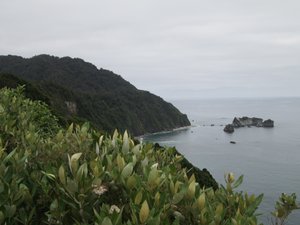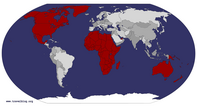Advertisement
Published: March 16th 2017

 IMG_1617
IMG_1617
Looks serene but this rugged coastline gets rough and angryAfter some really grey, cold and wet weather, we woke to brilliant clear blue skies which set the pulses racing as we slipped away quietly from the splendour of Lake Brunner. My trusty navigator had spotted a back country road to Route 6 and our onward journey down the lower West Coast. It turned out to be a great choice as this was real NZ back country with verdant green pastures flanked by steeply rising and wooded mountains. This must be a tough place to be in winter as the outside temperature was 5 deg C not forgetting that this is still early autumn. The road wound it's way around Lake Brunner and every now and then we would spot a solitary wooden cabin hidden in the trees and I guess if you really wanted to get away from it all, this would be the place to be.
An update on tourism in NZ. Over early morning coffee (minus rusks...dammit!!), I had read

 IMG_1569
IMG_1569
Happy travellers on wood strewn beach at Hokitikaan article on Bloomberg about NZ's exploding tourism industry which is becoming a challenge as there is just not enough hospitality infrastructure to cope with numbers arriving in the country. In peak season (Dec- end Jan) there aren't enough beds and the major attractions are simply unable to cope with human numbers and disposal of waste. The tourism guys are concerned that a few bad experiences could tarnish the image of NZ and slow tourism. In a sense I can understand the challenge. The number of people touring is phenomenal and on the road one is constantly seeing sees buses, campervans, cyclists and backpackers. At some point I got "Statistician Sue" onto the job and she counted 30 consecutive oncoming vehicles and here is the thing....16 of them were campervans! So our Happy Black Sheep is never alone and in fact occasionally sees a close relative cruise by. Despite this we never feel overwhelmed or over run by fellow travellers.
A quick word about the West Coast. It's rugged but spectacular 500 km coast line is populated by roughly 40,000 hardy citizens. So the numbers of early settlers and speculators to this region have not swelled and this is

 IMG_1599
IMG_1599
Great view of Okarito Lagoon with camp site and airfield on left banklargely due to the gold rush ending and it being undoubtedly a harsh place to live considering rainfall abundance and bitingly cold winters. This relative lack of population in a bizarre way is what makes the West Coast so unique and appealing. Lots of arty, crafty spots along the way and then a few "settlements" which don't quite qualify to be called towns. First up was Hokitika (pop 4,000) which owes it's legacy to mining of greenstone and jade. Legend has it that the first Maoris to arrive here used to lug these precious stones across the Southern Alps to the merchants on the other side. When one looks at the sheer vertical heights of these mountains you wonder how they did this. So it was precious stones and some gold that kicked the can down the road in the 1860's. It also has a wild, windy beach strewn with a large number of huge chunks of driftwood washed onto the beach. The LPG sums it up well..."you might be excused for thinking you've stumbled into a real Wild West town". Further down the road was a place called Ross whose sole claim to fame is that NZ's largest gold

 IMG_1614
IMG_1614
Menacing Frans Josef glacier inching it's way down the valleynugget of 2.7kg was found there. The LPG has this to say..."Ross is a town of glories lost". A bit harsh but not much there. And then the real crown jewel as one drifts alongside, not into, Pukekura (pop 2). Again the LPG does a better job than I could..."an overly rustic cafe shop with a pathological distrust of possums, animal activists and Aucklanders". The cafe offers snacks like possum jerky and possum pie. So, you have these really quirky little towns to ponder over and the unending scenery as the road meanders onwards providing breathtaking views of natural forest, mountains and countless rivers and streams rushing to the coast.
The possum. During our travels to date we had seen a number of signs denoting "Ban 1080". Turns out this is a pesticide mixed into baits to kill possums, stoats and rats. It's controversial to say the least as there are many who believe it kills more than intended. Bit odd considering there are no indigenous mammals to speak of. The pesky possum is a huge problem. They are vegetarian (which is good I guess) but they nosh shoots of new saplings which is really stuffing up the growth

 IMG_1605
IMG_1605
The HBS with it's nose out sharing the Inn with many othersof trees and other vegetation. Then when opportunity presents itself they eat birds eggs and in particular the highly endangered Kiwi eggs. Sadly, those eggs that survive produce Kiwi chicks which are then eaten by stoats.The Kiwi, a flightless bird, is highly endangered.
Having done a thorough internet search including the statutory TripAdvisor check, we drifted into Okarito camp park mid afternoon in beautiful sunshine. This park is located on the Okarito Lagoon which happens to be the largest wetland in NZ covering 3,000ha of open tidal water. I had also gleaned information about it's fishing potential which looked promising for sea run trout and salmon (a species I simply have to catch). An incredible aspect of NZ is the huge number of national parks located everywhere one travels. Each of these scenic park areas have superbly laid out, clearly marked and identified walkways. Having strapped on walking shoes we set off on a 4.2km round trip which took us to an elevated viewing platform which provided wonderful views across the valleys of the glaciers and Mount Cook, NZ's highest mountain at 3,724 m. Stunning!
The Okarito river mouth was a short 5 minute stroll from our camp site and I set off kitted out with a 9wt surf fly rod. Thrashed the water for at least an hour observing a gorgeous pinky sunset. No fish, but for the superb setting I could have spent another hour or two there. Back to camp. There was no pre-booking at Okarito. You arrive and pay via envelope into a trust box. We had secured an "A grade" site by arriving mid afternoon but by late afternoon there was no room at the Inn, so to speak. Campervans and campers in tents lined up cheek by jowl and one should feel claustrophobic but strangely you don't. I think it's because of a subtle "camp park code" which regulates how the camping fraternity behave. (1) No noise (2) Clean up everything after use (3) Do not charge the showers or toilets (4) Greet and be nice to each other. Believe me, even with larger numbers it's pleasant and it all works. Our close by neighbours were two German girls who were intriguing as we couldn't figure out how they were both going to fit into and sleep in their car. Somehow they did.
Another little snippet about a number of camp parks we had stayed in is that they were located next to an airstrip (not quite an "Airport" as the signage always indicated). Got me thinking. Why? Certainly good news for the hordes of grey nomads travelling in the sense that any untoward death like symptom could see one airlifted to seek medical attention quickly.
With the one night stand at Okarito behind us we set off further down the West Coast and drifted into Frans Josef where the glacier of the same name is located nearby. If one blinked and forgot for a moment where you were, this could easily be a spunky little village in the ski areas of Austria. In season apparently overrun with tourists but we were able to do the 6km round trip walk not having to bob and weave the traffic on the walkway. At the car park it was cloudy, misty and cool but 1km up the walkway we stepped into brilliant sunshine making for fantastic viewing of the glacier. The walkway ends about 200m from the glacier which interestingly is only 270m above sea level. This icy marvel is fed with 16 meters (wow!) of rain and snow annually and is estimated to be advancing by up to 70 cm per day. Awesome sight.
In case you really are into the glacier thing, Fox Glacier is located a little further down Route 6. Unfortunately this area was covered in low cloud and mist and viewing of the glacier would not have been good. Onwards we trundled and took a small deviation to Lake Paringa which offered very basic camp park facilities. We had considered spending a night there subject to checking the facilities out. Seriously basic...no showers and then the "kamakaze" like attack by hordes of sand flies was all Sue needed to scrap the idea instantly. I kitted up and thrashed the water for an hour or so in quest of a salmon but with no luck. It will change!
Plan B is often the order of the day and just down the drag is Haast (pop 300) which is the last town on the West Coast and probably survives on tourists moving up and down this marvellous coastline. We opted for the luxury of a Top 10 camp park and will spend two nights here affording time to do the household chore stuff e.g washing clothes and cleaning, tidying the HBS. Also provides an opportunity to study the next region for exploration with an eye on the far south and Milford Sound. Long range forecasts look dodgy with rain the order of the day but one needs to keep in mind the deep south has 6,000 mm a year so the prospects of it raining are very high.
Footnote. You can expand picture size by clicking on them. Keep the messages and comments coming.
Advertisement
Tot: 0.213s; Tpl: 0.013s; cc: 11; qc: 49; dbt: 0.0804s; 1; m:domysql w:travelblog (10.17.0.13); sld: 1;
; mem: 1.1mb











Barrie Irons
non-member comment
Seems like the Elliott's are enjoying the relaxing camper life! Western Coast of South Island seems pretty rugged, much like our West Coast. Looking forward to our visit in August.